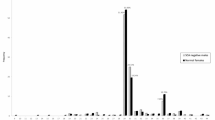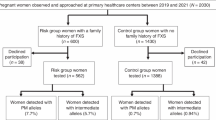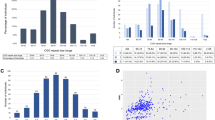Abstract
Background:
Fragile X syndrome (FXS) is the most common cause of inherited intellectual disabilities and autism. The reported prevalence of the full mutation (FM) gene FMR1 in the general population is 0.2–0.4 per 1000 males and 0.125–0.4 per 1000 females.
Population screening for FMR1 expanded alleles has been performed in newborns and in an adult population. However, it has never been carried out in an entire town.
Ricaurte is a Colombian district with 1186 habitants, with a high prevalence of FXS, which was first described by cytogenetic techniques in 1999.
Methods:
Using a PCR-based approach, screening for FXS was performed on blood spot samples obtained from 926 (502 males and 424 females) inhabitants from Ricaurte, accounting for 78% of total population.
Results:
A high prevalence of carriers of the expanded allele was observed in all FXS mutation categories. Using the Bayesian methods the carrier frequency of FM was 48.2 (95% Credibility Region CR: 36.3–61.5) per 1000 males and 20.5 (95% CR:13.5–28.6) per 1000 females; the frequency of premutation carrier was 14.1 (95% RC: 8.0–21.7) per 1000 males (95% RC: 8.0–21.7 per 1000 males) and 35.9 (95% RC: 26.5–46.2) per 1000 for females (95% RC: 26.5–46.2 per 1000 females), and gray zone carrier was 13.4 (95% RC: 7.4–20.7) per 1000 males (95% RC: 7.4–20.7 per 1000 males) and 42.2 (95% RC: 32.2–53.8) per 1000 for females (95% RC: 32.2–53.8 per 1000 females). Differences in carrier frequencies were observed for premutation and FM alleles between natives and non-natives.
Conclusions:
This study shows that in Ricaurte the carrier frequencies of FMR1 expanded alleles (premutations and FMs) are higher than those reported in the literature, suggesting that Ricaurte constitutes a genetic cluster of FXS.
Similar content being viewed by others
Log in or create a free account to read this content
Gain free access to this article, as well as selected content from this journal and more on nature.com
or
References
Hagerman RJ, Hagerman PJ. Fragile X syndrome: diagnosis. In: Hagerman RJ, Hagerman PJ, editors. Treatment and research. 3rd ed. Baltimore: The John Hopkins University Press; 2002.
Harris SW, Hessl D, Goodlin-Jones B, Ferranti J, Bacalman S, Barbato I. et al. Autism profiles of males with fragile X syndrome. MacLean WE Jr, Abbeduto L. (eds) Am J Ment Retard. 2008. p. 427–38.
Loesch DZ, Huggins RM, Bui QM, Epstein JL, Taylor AK, Hagerman RJ. Effect of the deficits of fragile X mental retardation protein on cognitive status of fragile x males and females assessed by robust pedigree analysis. J Dev Behav Pediatr. 2002;23:416–23.
Hagerman R, Hagerman P. Advances in clinical and molecular understanding of the FMR1 premutation and fragile X-associated tremor/ataxia syndrome. Lancet Neurol. 2013;12:786–98.
Saldarriaga W, Forero JV, Gonzalez LY, Hagerman R. Síndrome de temblor y ataxia asociado a frágil X (FXTAS): revisión de la literatura. Acta Neurol Colomb. 2015;31:325–34.
Wheeler AC, Bailey DB, Berry-Kravis E, Greenberg J, Losh M, Mailick M, et al. Associated features in females with an FMR1 premutation. J Neurodev Disord. 2014;6:18.
Roberts JE, Tonnsen BL, McCary LM, Ford AL, Golden RN, Bailey DB. Trajectory and predictors of depression and anxiety disorders in mothers with the FMR1 premutation. Biol Psychiatry. 2016;79:850–7.
Grigsby J, Cornish K, Hocking D, Kraan C, Olichney JM, Rivera SM, et al. The cognitive neuropsychological phenotype of carriers of the FMR1 premutation. J Neurodev Disord. 2014;6:28.
Tassone F, Iong KP, Tong T-H, Lo J, Gane LW, Berry-Kravis E, et al. FMR1 CGG allele size and prevalence ascertained through newborn screening in the United States. Genome Med. 2012;4:100.
Coffee B, Keith K, Albizua I, Malone T, Mowrey J, Sherman SL, et al. Incidence of fragile X syndrome by newborn screening for methylated FMR1 DNA. Am J Hum Genet. 2009;85:503–14.
Tassone F. Advanced technologies for the molecular diagnosis of fragile X syndrome. Expert Rev Mol Diagn. 2015;15:1465–73.
Song F, Barton P, Sleightholme V, Yao G, Fry-Smith A. Screening for fragile X syndrome: a literature review and modeling study HTA Health Technology Assessment NHS R&D HTA Programme Executive Summary Screening for fragile X syndrome. Health Technol Assess (Rockv). 2003;7:1–106.
Hunter J, Rivero-Arias O, Angelov A, Kim E, Fotheringham I, Leal J. Epidemiology of fragile X syndrome: a systematic review and meta-analysis. Am J Med Genet A. 2014;164A:1648–58.
Meguid N, Abdel-Raouf E, Dardir A, El AM. Prevalence of fragile X syndrome among school-age Egyptian males. World J Pediatr. 2007;3:271–5.
Puusepp H, Kahre T, Sibul H, Soo V, Lind I, Raukas E, et al. Prevalence of the fragile X syndrome among Estonian mentally retarded and the entire children’s population. J Child Neurol. 2008;23:1400–5.
Turner G, Webb T, Wake S, Robinson H. Prevalence of fragile X syndrome. Am J Med Genet. 1996;64:196–7.
Tzeng C-C, Tsai L-P, Hwu W-L, Lin S-J, Chao M-C, Jong Y-J, et al. Prevalence of the FMR1 mutation in Taiwan assessed by large-scale screening of newborn boys and analysis of DXS548-FRAXAC1 haplotype. Am J Med Genet A. 2005;133A:37–43.
Chow JC, Chen D-J, Lin C-N, Chiu C-Y, Huang C-B, Chiu P-C, et al. Feasibility of blood spot PCR in large-scale screening of fragile X syndrome in southern Taiwan. J Formos Med Assoc. 2003;102:12–6.
Rifé M, Badenas C, Mallolas J, Jiménez L, Cervera R, Maya A, et al. Incidence of Fragile X in 5,000 consecutive newborn males. Genet Test. 2003;7:339–43.
Saldarriaga W, Tassone F, González-Teshima LY, Forero-Forero JV, Ayala-Zapata S, Hagerman R. Fragile X syndrome. Colomb Med (Cali, Colomb). 2014;45:190–8.
Hagerman RJ, Hagerman P. Fragile X-associated tremor/ataxia syndrome—features, mechanisms, and management. Nat Rev Neurol. 2016;12:403–12.
Payan C, Saldarriaga W, Isaza C, Alzate A. Estudio focoendémico de retardo mental en Ricaurte Valle. In: XI premio Aventis—Academia Nacional de Medicina a la investigaciónmédica. 2000. p. 12–20.
Filipovic-Sadic S, Sah S, Chen L, Krosting J, Sekinger E, Zhang W, et al. A novel FMR1 PCR method for the routine detection of low abundance expanded alleles and full mutations in fragile X syndrome. Clin Chem. 2010;56:399–408.
Tassone F, Pan R, Amiri K, Taylor AK, Hagerman PJ. A rapid polymerase chain reaction-based screening method for identification of all expanded alleles of the fragile X (FMR1) gene in newborn and high-risk populations. J Mol Diagn. 2008;10:43–9.
Maddalena A, Richards CS, Mcginniss MJ, Brothman A, Desnick RJ, Grier RE, et al. Technical standards and guidelines for fragile X: the first of a series of disease-specific supplements to the standards and guidelines for clinical genetics laboratories of the American College of Medical Genetics.
Forster J, O’Hagan A. Kendalls advanced theory of statistics. 2nd ed., vol. 2B (Pb 2015) London: Willey India Exclusive; 2015.
Gelman A, Carlin JB, Stern HS, Dunson DB, Vehtari A, Rubin DB. Bayesian data analysis. 3rd ed. Chapman and Hall/CRC; 2013.
Sturtz S, Ligges U, Gelman A. R2WinBUGS: A package for running WinBUGS from R. J Stat Softw. 2005;12:1–16.
Hagerman PJ. The fragile X prevalence paradox. J Med Genet. 2008;45:498–9.
Fernandez-Carvajal I, Walichiewicz P, Xiaosen X, Pan R, Hagerman PJ, Tassone F. Screening for expanded alleles of the FMR1 gene in blood spots from newborn males in a Spanish population. J Mol Diagn. 2009;11:324–9.
Lopez-Bedoya LM, Ayala-Rodriguez GI. Levantamiento historico corregimiento de Ricaurte municipio de Bolivar. Universidad Tecnologica de Pereira; 1997.
Salcedo-Arellano MJ, Lozano R, Tassone F, Hagerman RJ, Saldarriaga W. Alcohol use dependence in fragile X syndrome. Intractable Rare Dis Res. 2016;5:207–13.
Saldarriaga W, Ruiz FA, Tassone F, Hagerman R. Down syndrome and fragile X syndrome in a Colombian woman: case report. J Appl Res Intellect Disabil. 2016;30:970–4.
Castilla EE, Schuler-Faccini L. From rumors to genetic isolates. Genet Mol Biol. 2014;37(Suppl):186–93.
Alvarez-Gardeazabal G. “El Divino”. Bogota: Plaza & Janes; 1986.
Saldarriaga W, Lein P, González Teshima LY, Isaza C, Rosa L, Polyak A, et al. Phenobarbital use and neurological problems in FMR1 premutation carriers. Neurotoxicology. 2016;53: 141–7.
Poletta FA, Orioli IM, Castilla EE. Genealogical data in population medical genetics: field guidelines. Genet Mol Biol. 2014;37(Suppl):171–85.
Crawford DC, Meadows KL, Newman JL, Taft LF, Scott E, Leslie M, et al. Prevalence of the fragile X syndrome in African-Americans. Am J Med Genet. 2002;110:226–33.
Pesso R, Berkenstadt M, Cuckle H, Gak E, Peleg L, Frydman M, et al. Screening for fragile X syndrome in women of reproductive age. Prenat Diagn. 2000;20:611–4.
O’Byrne JJ, Sweeney M, Donnelly DE, Lambert DM, Beattie ED, Gervin CM, et al. Incidence of Fragile X syndrome in Ireland. Am J Med Genet A. 2017;173:678–83.
Acknowledgements
This work was supported by UC Davis Seed Grant and by the Universidad del Valle (Colombia) grant 1771. Special thanks to Asuragen, Inc. for providing supplies for this screening study.
Author information
Authors and Affiliations
Corresponding authors
Ethics declarations
Conflict of interest
RJH has received funding from Alcobra, Neuren, Novartis, Roche, and Marinus regarding treatment studies in fragile X syndrome. RJH has also consulted with Zynerba and Ovid regarding treatment studies in fragile X syndrome. FT has received funding from Asuragen, Inc.
Additional information
Publisher's note: Springer Nature remains neutral with regard to jurisdictional claims in published maps and institutional affiliations.
Rights and permissions
About this article
Cite this article
Saldarriaga, W., Forero-Forero, J.V., González-Teshima, L.Y. et al. Genetic cluster of fragile X syndrome in a Colombian district. J Hum Genet 63, 509–516 (2018). https://doi.org/10.1038/s10038-017-0407-6
Received:
Revised:
Accepted:
Published:
Issue date:
DOI: https://doi.org/10.1038/s10038-017-0407-6
This article is cited by
-
Understanding pathophysiology in fragile X syndrome: a comprehensive review
Neurogenetics (2024)
-
Phenotypic variability to medication management: an update on fragile X syndrome
Human Genomics (2023)



